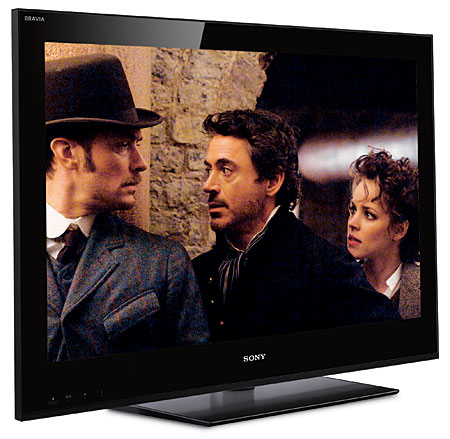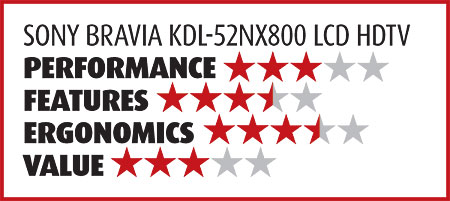Sony BRAVIA KDL-52NX800 LCD HDTV Page 2
 The remote is backlit, but the lighting only outlines the buttons; it doesn’t illuminate the lettering. You can see where the buttons are in the dark, but you can’t see what they do. Still, after you become familiar with the buttons you use most often, the lighting might help you find them. The remote doesn’t have any direct input access buttons, but the Input button brings up a list of the inputs and cycles through the active ones.
The remote is backlit, but the lighting only outlines the buttons; it doesn’t illuminate the lettering. You can see where the buttons are in the dark, but you can’t see what they do. Still, after you become familiar with the buttons you use most often, the lighting might help you find them. The remote doesn’t have any direct input access buttons, but the Input button brings up a list of the inputs and cycles through the active ones.
Internet-centric features are now required of any self-respecting higher-end HDTV. As of this writing, I counted 28 available BRAVIA Internet Video content services on the Sony, including YouTube, Yahoo!, podcasts, music videos, movie trailers, and more. Some of these sites looked surprisingly good, even those that were clearly SD. However, some links that claimed to be HD clearly weren’t. The KDL-52NX800 also has a variety of widgets. Apart from the LAN terminal, a built-in wireless LAN device (not tested) lets you access the Internet and your home network.
The Sony’s onboard audio is hardly a substitute for a good external sound system. Still, it was average for a flat-panel display, and it was reasonably tolerable at modest listening levels.
Firing It Up
The KDL-52NX800 performed well on our HD Video Test Bench. It only stumbled on horizontal chroma (color) resolution at the highest frequency test burst. The set also failed both of our SD 2:2 and 3:2 deinterlacing and upconversion tests. I watched hours of native 480i programming from some pretty stank sources (SyFy channel in SD, anyone?), both film- and video-based. While I saw some occasional artifacts, they were rare and easy to ignore.
Despite that modest rolloff in HD chroma resolution at the highest tested frequency, the Sony’s subjective resolution was excellent. I could easily spot the difference in sharpness between a merely fair Blu-ray Disc and a superb one. The average HD video quality of The Invention of Lying was clear from the start. When I popped in Pirates of the Caribbean: The Curse of the Black Pearl, I saw how crisp this set can look with a pristine video transfer. The Sony occasionally looked a shade oversharp (with the Sharpness control turned down to zero), but this only occurred on a few isolated scenes. I didn’t see any evidence of edge sharpening from testpattern discs. The set simply appeared to serve up sources as they were.
The post-calibration color results (see HT Labs Measures) also confirmed my subjective impression: The Sony’s color offers little to complain about. In fact, it was almost good enough before calibration (in Warm 2) that I was tempted to leave it alone (although we can’t confirm that all samples will be this good off the line). Some sets can produce a marginally tighter measured calibration, such as the LG INFINIA 47LE8500 can with its 10-step calibration controls (also reviewed in this issue). However, as a practical matter, I can’t imagine anything in the Sony’s color performance that would prevent you from opening up your checkbook. Of course, you won’t be able to judge this in a showroom, where every set is awash in the blue glow of an overly high color temperature and the most vivid picture settings available. Still, the Sony’s color never disappointed me. If you keep your hands off the Live Color control, fleshtones and bright greens—the two hardest colors to get right because we see them every day—are no exception.
Nearly all LCD flat-panel displays perform poorly off axis. That includes this Sony. If you move much beyond 20 degrees from the center seat, the image begins to lighten perceptibly. Three viewers on an average-sized couch, 8 feet or more from the screen, will enjoy a reasonably consistent picture. However, if you move much beyond that, it will quickly become compromised.

The Sony’s Achilles’ heel is black level uniformity. If you display a full-screen black image—including black fadeouts between scenes in a movie or television show—you’ll see an image that’s dark gray in some areas and lighter gray in others. It’s much like a fuzzy inkblot test. The culprit is less than perfect diffusion of the edge backlighting. We’ve seen this problem in other LED edge-lit LCD HDTVs we’ve tested (a limited number to date; this is the first such design we’ve checked out from Sony).
Still, this nonuniformity was inconspicuous on most programming. And not just on medium-bright or bright material; many scenes that most viewers would call dark don’t show it, and room lighting will often (but not always) camouflage it. The same goes for an overly high setting on the Brightness control, or if you engage the ACE (which I didn’t like for other reasons). You’ll certainly never see it in a dealer’s showroom. Much of the time, the Sony’s subjective contrast is impressive. The overall image is convincingly dimensional, and it shows few signs of the flat, gray blandness that’s a traditional LCD weakness. But on extremely dark, low-contrast scenes, or with films such as Terminator Salvation or Harry Potter and the Half-Blood Prince that are saturated with them, you can’t miss the problem. In our sample, it most often showed up on the left side of the screen, particularly the lower left, where blacks were the lightest. When just part of the screen looks wrong, it’s like an itch you can’t scratch.
Another smaller issue is a (likely) programmed ramp-down of brightness on a full-black screen. We’ve seen this on other sets to different degrees, and not all of them were from Sony. When you first display a full-screen black image on the KDL-52NX800, it remains stable for roughly 7 seconds. After that, it dims visibly. After another 25 seconds, the screen turns completely dark—the LEDs having apparently shut off.
Given the time involved for both of these ramp-downs, I don’t feel that they are picture issues. The second stage of the drop (LEDs off) might simply be a power-saving feature. A cynic might consider the drop at 7 seconds a way to improve the set’s black level. But few black fadeouts last as long as 7 seconds, so you’ll rarely see the decrease. I’ve never seen Sony make any specific contrast ratio claims for any of its flat-panel displays.
Conclusions
The Sony’s uneven black level is something of a fly in the soup of an otherwise very tasty dish. You won’t see it often. Some of you may never see it at all, particularly if you don’t do a lot of viewing in a dim or dark room. But as with other edge-lit sets we’ve tested, it tempers our enthusiasm for a set in this price range. However, on most source material, the BRAVIA KDL-52NX800, properly set up, produces a terrific image, with rich, natural color, excellent resolution, respectable video processing, and nearly always impressive contrast.
























































